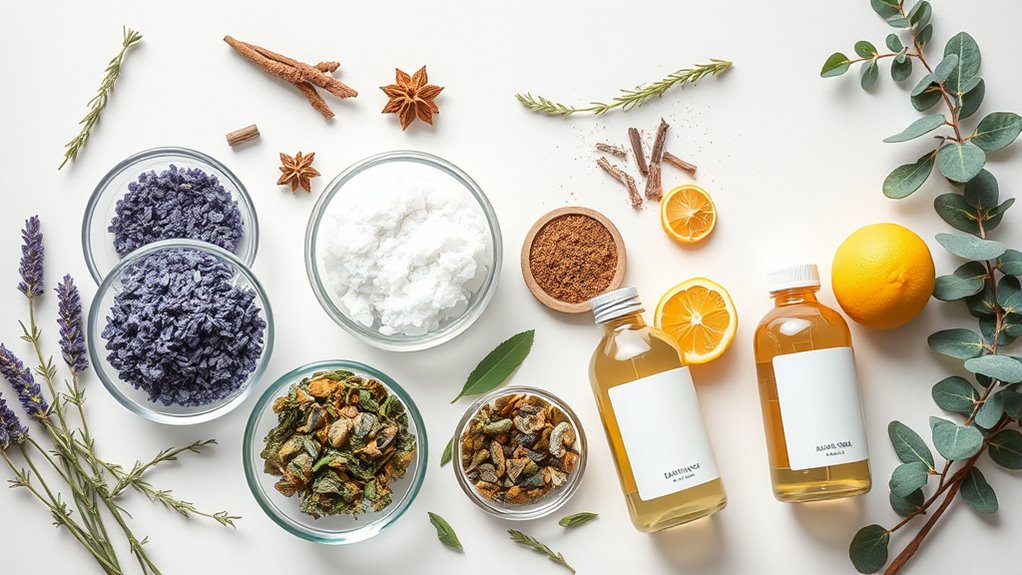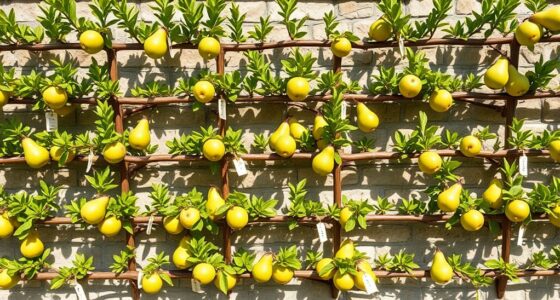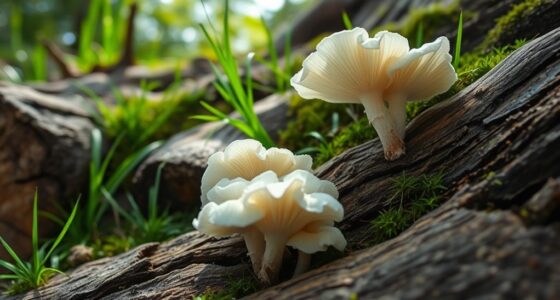To guarantee your detergent is greywater-safe, avoid ingredients like phosphates, borates, chlorine bleach, synthetic fragrances, dyes, and non-biodegradable surfactants like SLS or SLES. Look for eco-friendly products that use plant-based, biodegradable ingredients, and are certified by eco-labels such as USDA Biobased or MADE SAFE®. Pay attention to labels for low salt content and pH balance, and choose brands that specify greywater compatibility. Continue exploring to discover more tips for sustainable laundry choices.
Key Takeaways
- Verify products are free of phosphates, borates, chlorine bleach, and synthetic fragrances to ensure greywater safety.
- Choose biodegradable, plant-based surfactants like alkyl polyglucosides and enzymes such as proteases and lipases.
- Look for eco-labels or certifications (e.g., USDA Biobased, MADE SAFE®, B Corporation) indicating safe, eco-friendly ingredients.
- Avoid harmful additives like formaldehyde, optical brighteners, and synthetic dyes that can damage ecosystems.
- Check product labels regularly for transparency and absence of harmful chemicals to maintain greywater system health.
Key Ingredients to Avoid in Greywater Detergents

To guarantee your greywater is safe for irrigation, you need to avoid certain ingredients in your detergents. First, steer clear of alkaline compounds, especially in bar soaps, as they raise pH levels and harm acid-loving plants like blueberries and azaleas. These high alkalinity levels can damage soil chemistry and plant health. Next, avoid boron and borate compounds, such as borax and sodium perborate, which are toxic to plants and accumulate in soil, causing damage over time. Also, stay away from phosphates, as they cause algae blooms in water systems, depleting oxygen and harming aquatic life. Finally, skip sodium-based salts like SLS and washing soda—they harm soil structure, are toxic to aquatic life, and can irritate your skin. Using detergents free from these ingredients helps protect your garden and the environment. Choosing plant-friendly options is essential to maintain a healthy greywater system and thriving garden. Additionally, selecting biodegradable and non-toxic environmentally safe ingredients supports broader ecological health and sustainability.
Characteristics of Eco-Friendly Laundry Products
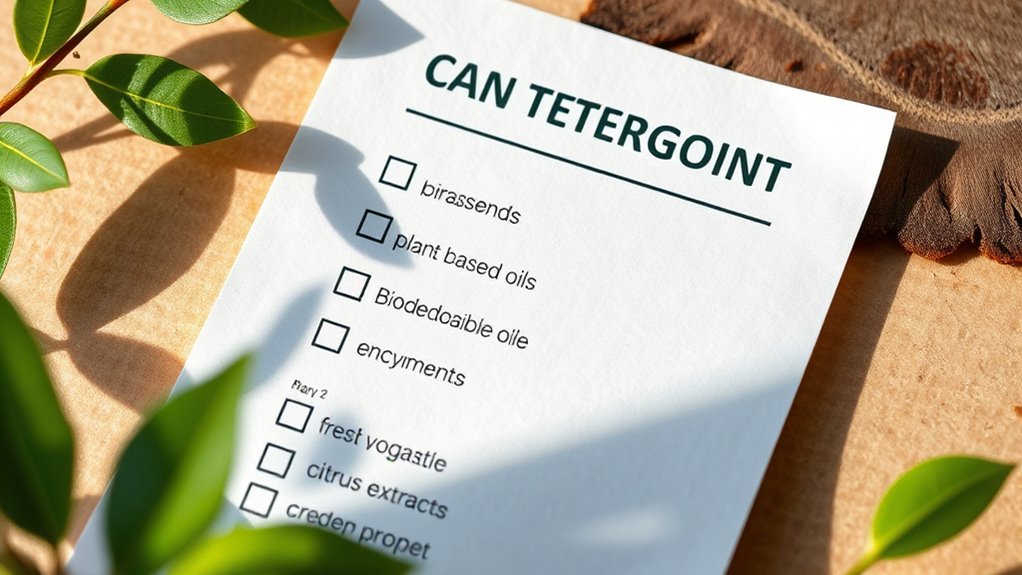
Eco-friendly laundry products stand out through their use of biodegradable ingredients, which naturally break down in the environment and prevent harmful buildup in waterways. These formulas rely on plant-based surfactants and enzymes like alkyl polyglucosides, proteases, lipases, and amylases, effectively removing stains without harming ecosystems. They often feature plant-derived ingredients from sources such as coconut oil, corn starch, and essential oils, reducing reliance on petroleum-based chemicals and supporting sustainability. Many are phosphate-free or low in phosphates, helping to prevent algal blooms and preserve aquatic life. Additionally, eco-friendly products are manufactured using energy-efficient processes that lower greenhouse gas emissions, ensuring a smaller overall environmental footprint. This commitment to sustainable manufacturing emphasizes the importance of reducing energy consumption and waste during production to further lessen environmental impact. Incorporating biodegradable packaging further enhances their eco-friendly profile by minimizing plastic waste.
Common Harmful Additives in Conventional Detergents
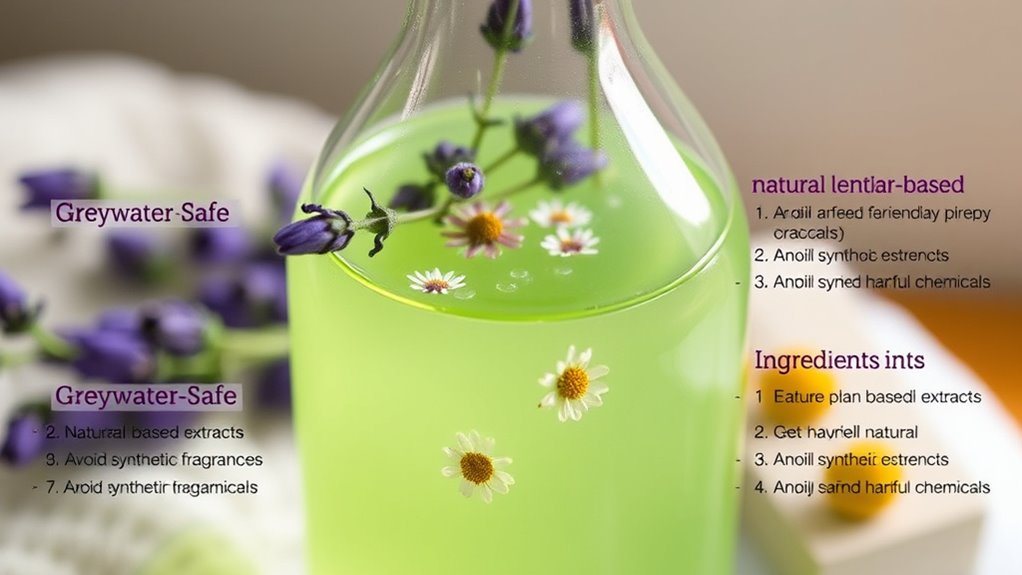
Many conventional detergents contain toxic chemical components and artificial additives that can harm your health and the environment. These substances, like phosphates and synthetic fragrances, often go unnoticed on labels but pose serious risks. Choosing products free from these harmful ingredients helps protect your family and our water systems. Research shows that exposure to certain chemicals in detergents can cause skin irritation, respiratory issues, and even contribute to chronic health problems over time. Additionally, some ingredients may interfere with skin barrier function, increasing vulnerability to irritants and allergens.
Toxic Chemical Components
Conventional detergents often contain harmful chemical additives that pose serious health and environmental risks. These ingredients can cause skin and respiratory irritation, damage aquatic ecosystems, and contribute to long-term health issues. You should be aware of common toxic components like:
- Phosphates: Linked to cardiovascular problems and algae overgrowth, leading to eutrophication. Phosphates can also disrupt aquatic habitats and threaten marine life, emphasizing the need for eco-friendly alternatives. Environmental impact
- Chlorine Bleach: Causes skin irritation and forms toxic compounds such as chloroform when mixed with water.
- Formaldehyde: A probable carcinogen, associated with skin irritation and serious health risks. Formaldehyde is often released from preservatives used in laundry products and can linger on fabrics, increasing exposure during regular use.
Other harmful chemicals include 1,4-dioxane, which persists in waterways and damages organs, and SLS/SLES, foaming agents that strip natural oils from your skin. These substances highlight the importance of choosing safer, eco-friendly alternatives.
Harmful Artificial Additives
Artificial additives in laundry detergents, such as synthetic fragrances, dyes, optical brighteners, preservatives, and other functional chemicals, are often included solely for aesthetic or shelf-life purposes rather than cleaning performance. Synthetic fragrances may contain undisclosed phthalates linked to hormonal disruption, cancer risk, and reproductive issues. They can trigger skin allergies and respiratory problems, especially in sensitive individuals. Artificial dyes add color but offer no cleaning benefit and can cause skin irritation, while also harming aquatic ecosystems. Optical brighteners make fabrics appear whiter but may cause dermatitis and are toxic to aquatic life. Preservatives like formaldehyde and parabens pose health risks, including carcinogenic effects and hormonal disruption. Many of these additives persist in water sources, contributing to environmental pollution and microplastic pollution. These harmful chemicals can also accumulate in the human body over time, potentially leading to long-term health issues. Additionally, the presence of synthetic chemicals in conventional detergents raises concerns about their impact on indoor air quality and overall ecological health.
Recognizing Safe and Effective Greywater-Compatible Brands

When selecting greywater-compatible brands, look for clear ingredient transparency on labels to guarantee they meet safety standards. Certifications and eco-labels can help verify that a product is biocompatible and free from harmful chemicals. By paying attention to these markers, you can confidently choose detergents that support healthy soil and plant life. Additionally, understanding dog breeds and their traits can help you select the most environmentally friendly and safe cleaning products suitable for pet owners.
Brand Ingredient Transparency
Brand ingredient transparency is essential for ensuring that your laundry detergents are safe and effective for greywater reuse. When brands clearly disclose all ingredients, including synthetics and salts, you can better assess their suitability. Transparent labels should specify salt content, highlighting low-salt options that won’t harm soil or plants. Additionally, knowing whether synthetic components like preservatives, fragrances, or colorants are present helps you avoid harmful additives. Look for brands that openly list pH balancing agents, such as citric acid, to confirm compatibility with greywater systems. Transparency also involves clearly indicating the absence of controversial chemicals like borates, optical brighteners, and chlorine bleach. This openness allows you to make informed choices, ensuring your cleaning routine supports a healthy, sustainable greywater cycle. Incorporating emotional regulation considerations can also help you select detergents that promote a calming environment for your home.
Certification and Labels
Certification and labels serve as straightforward guides to identify laundry detergents that are safe and effective for greywater reuse. Look for certifications like USDA Certified Biobased Product, which indicates high renewable content, or MADE SAFE®, ensuring non-toxic ingredients. The Leaping Bunny label confirms cruelty-free formulas, while B Corporation certifies companies committed to social and environmental performance. Products rated “A” by EWG are generally safer for greywater systems. Specific labels such as “graywater-compatible,” “garden-friendly,” or “dioxane-free” directly address greywater safety, highlighting formulations safe for irrigation and soil health. Biodegradable, vegan, and phosphate-free labels further support eco-friendliness. These certifications and labels help you select detergents that meet safety, sustainability, and greywater compatibility standards, making eco-conscious laundry choices easier and more reliable. Incorporating eco-label recognition into your selection process can help ensure you choose products aligned with environmentally responsible practices.
Reading Labels: What to Look for and What to Skip

Reading detergent labels carefully is essential to choosing products that are safe for greywater reuse. You need to identify ingredients that could harm soil, plants, or aquatic ecosystems. Look for labels mentioning biodegradability and certifications like EPA or Green Seal, as these indicate environmental safety. Avoid products containing phosphates, SLS, chlorine, boron compounds, or synthetic fragrances, as these can damage microbes, plants, and water quality. Focus on labels that list natural surfactants, citric acid, glycerin, and plant-based oils. Be cautious of terms like “biodegradable” or “natural,” which may be misleading without ingredient verification. Prioritize fragrance-free, pH-balanced liquids with minimal synthetic components. Regularly review labels, as formulations can change, ensuring your detergent remains greywater-safe and environmentally friendly. Being aware of microbial health can help you choose detergents that support beneficial microbes in greywater systems.
Impact of Detergent Ingredients on Soil and Water Health
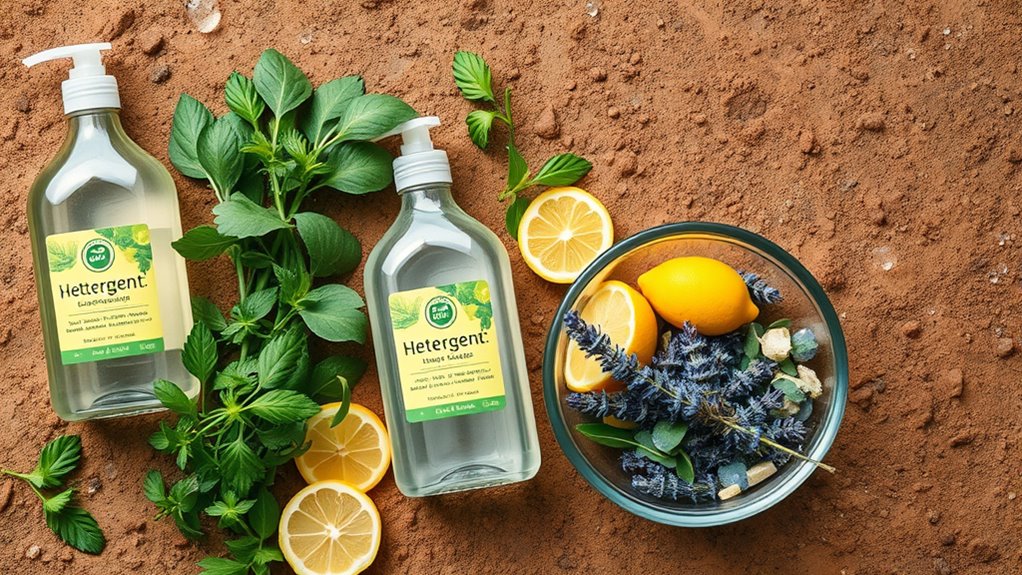
Impact of Detergent Ingredients on Soil and Water Health
Detergent ingredients can substantially impact soil and water health by altering chemical balances and disrupting essential biological processes. Many detergents increase soil pH, disrupting acidity levels crucial for microorganisms, and reduce nutrients like nitrogen and potassium, impairing plant growth. Phosphates from detergents often cause nutrient imbalances and contribute to water eutrophication, harming aquatic life. Surfactants, especially synthetic ones, disturb beneficial soil microbes, reducing soil fertility and impairing organic matter breakdown. Non-biodegradable chemicals accumulate in soil and leach into groundwater, leading to long-term contamination. These disruptions compromise soil structure, water infiltration, and septic system function, increasing risks of clogging and contamination. Using biodegradable and phosphate-free detergents helps protect soil and water ecosystems from these harmful impacts, promoting environmental sustainability.
Tips for Maintaining a Sustainable Greywater System

Maintaining a sustainable greywater system requires careful attention to design, installation, and ongoing upkeep. Proper system design ensures efficient water flow and durability, so choose corrosion-resistant materials and select pumps suited to grey water characteristics. Regular maintenance keeps the system functioning at its best; perform full flushes at winter’s start and end, inspect driplines and emitters for blockages, and clean filters every four to six months. Proper plant placement and health monitoring prevent overwatering and promote growth. Safety measures, like wearing gloves during maintenance and establishing emergency procedures, protect you from risks. To enhance performance, manage flow rates, consider gravity-based systems for energy savings, and periodically evaluate the need for upgrades. Routine maintenance checks and cleaning Staying proactive ensures your greywater system remains eco-friendly and effective.
Frequently Asked Questions
How Can I Verify a Detergent’s Biodegradability Certification?
To verify a detergent’s biodegradability certification, start by reviewing the certification body’s documentation requirements. You’ll need to submit detailed product info, testing reports (like OECD 301 series), and safety data sheets. The certifier will audit your data, test results, and manufacturing practices. Once approved, you’ll receive the certification, but remember, ongoing audits are necessary to uphold compliance and ensure your product continues meeting biodegradability standards.
Are There Natural Alternatives to Commercial Greywater-Safe Detergents?
You’re interested in natural alternatives to commercial greywater-safe detergents. You can opt for plant-based options like homemade castile soap, which uses olive oil and natural alkali, or look for brands like Seventh Generation or ECOS that use biodegradable, plant-derived ingredients. These products avoid harmful chemicals, reduce environmental impact, and are safe for greywater reuse. Always check labels for natural ingredients and eco-certifications to guarantee safety and biodegradability.
What Are Signs My Greywater System Is Affected by Detergent Use?
So, your greywater system’s throwing a tantrum, huh? Look for signs like foul odors, slow drainage, or unexpected plant damage. If you notice algae blooms or increased soil salinity, detergents might be to blame. Clogs or green scum are your system’s way of saying, “Help!” Keep an eye on chemical levels, and stick to eco-friendly soaps to prevent this drama. Your greywater system will thank you!
Can I Make My Own Greywater-Safe Detergent at Home?
Yes, you can make your own greywater-safe detergent at home. Use natural ingredients like Castile soap, washing soda, and optional essential oils. Mix grated soap with washing soda and water for a liquid or powder version. Avoid harsh chemicals, synthetic fragrances, and phosphates to protect plants and soil. Measure carefully, store in clean containers, and use just enough per load. Homemade options are safer and environmentally friendly for greywater reuse.
How Often Should I Test My Soil for Salt Buildup?
You should test your soil for salt buildup annually to keep track of salt levels over time. If you use greywater with high salt content or live in an arid climate, consider testing more often—biannually or quarterly. Always check the soil at the root zone, around 0-30 cm deep, and monitor electrical conductivity to catch early signs of salt stress before it harms your plants.
Conclusion
Now that you know which ingredients to avoid and what to look for, your choices can truly make a difference. But the journey doesn’t end here—hidden additives and overlooked labels can still surprise you. Will your next detergent be safe for your greywater system and the environment? Stay vigilant, ask the right questions, and keep exploring. The future of sustainable laundry depends on your awareness—are you ready to make the switch?
I’m Theodore, and I love tiny houses. In fact, I’m the author of Tiny House 43, a book about tiny houses that are also tree houses. I think they’re magical places where imaginations can run wild and adventures are just waiting to happen.
While tree houses are often associated with childhood, they can be the perfect adult retreat. They offer a cozy space to relax and unwind, surrounded by nature. And since they’re typically built on stilts or raised platforms, they offer stunning views that traditional homes simply can’t match.
If you’re looking for a unique and romantic getaway, a tree house tiny house might just be the perfect option.
